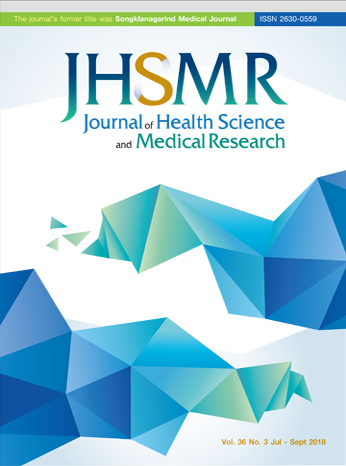Effects of Vitamin E on Transfusion Requirements in TransfusionDependent Beta-Thalassemia Patients
DOI:
https://doi.org/10.31584/jhsmr.2018.36.3.19Keywords:
antioxidant, blood transfusion, hemoglobin, oxidative stress, thalassemia, vitamin EAbstract
Objective: To evaluate the volume of blood transfusion requirements as well as hemolytic and oxidative biochemical variables in transfusion-dependent β-thalassemia patients supplemented with vitamin E.
Material and Methods: A prospective, double-blind, randomized, placebo-controlled, crossover study was undertaken between December, 2012 and September, 2014 in the Pediatric Clinic of Songklanagarind Hospital. The participants were β-thalassemia major and Hb E/β-thalassemia patients aged between 5 and 18 years. A random allocation sequence was generated to receiving either 6 months of vitamin E or placebo followed by a 3-month washout period and then switching to another drug for 6 months. The outcome variable measurements were the volumes of the transfused packed red cells, and the hemolytic and oxidative biochemical variables.
Results: Thirty-nine patients were enrolled into the study. All of them had significantly low levels of vitamin E and reduced glutathione levels, as well as high levels of oxidative stress shown by significantly high levels of malondialdehyde, superoxide dismutase, and glutathione peroxidase. The vitamin E levels became normal after the 6-month period of 200-400 milligram per day of oral vitamin E intake. All of the measured oxidative stress parameters did not improve except for the glutathione peroxidase level. Moreover, there was no difference in the volumes of transfused packed red cell requirements as well as hemolytic parameters like aspartate transaminase, lactate dehydrogenase, reticulocyte count and total bilirubin levels. Finally, no adverse reactions to oral vitamin E were found.
Conclusion: Vitamin E supplementation normalized the vitamin E level and possibly partially reduced oxidative stress, but there was no difference in the volume of transfusion requirements or the hemolytic parameters in transfusion-dependent β-thalassemia patients.
References
2.Panich V, Pornpatkul M, Sriroongrueng W. The problem of thalassemia in Thailand. Southeast Asian J Trop Med Public Health 1992;23:1-6.
3.Martin A, Thompson AA. Thalassemias. Pediatr Clin N Am 2013; 1383-91.
4.Cappellini MD, Cohen A, Porter J, Taher A, Viprakasit V. Guide lines for the management of transfusion dependent thalas semia (TDT). 3rd ed. Nicosia: Thalassaemia International Federation, 2014.
5.Fucharoen S, Winichagoon P. Haemoglobinopathies in Southeast Asia. Indian J Med Res 2011;134:498-506.
6.Tavazzi D, Duca L, Graziadei G, Comino A, Fiorelli G, Cappellini MD. Membrane-bound iron contributes to oxidative damage of beta-thalassaemiaintermedia erythrocytes. Br J Haematol 2001;112:48-50.
7.Advani R, Sorenson S, Shinar E, Lande W, Rachmilewitz E, Schrier SL. Characterization and comparison of the red blood cell membrane damage in severe human alpha-and beta thalassemia. Blood 1992;79:1058-63.
8.Rund D, Rachmilewitz E. Beta-thalassemia. N Engl J Med 2005;353:1135-46.
9.Ghone RA, Kumbar KM, Suryakar AN, Katkam RV, Joshi NG. Oxidative stress and disturbance in antioxidant balance in beta thalassemia major. Indian Clin Biochem 2008;23:337-40.
10.Naithani R, Chandra J, Bhattacharjee J, Verma P, Narayan S. Peroxidative stress and antioxidant enzymes in children with beta-thalassemia major. Pediatr Blood Cancer 2006;46:780-5.
11.Das N, Das Chowdhury T, Chattopadhyay A, Datta AG. Attenuation of oxidative stress-induced changes in thalassemic erythrocytes by vitamin E. Pol J Pharmacol 2004;56:85-96.
12.Cighetti G, Duca L, Bortone L, Sala S, Nava I, Fiorelli G, et al. Oxidative status and malondialdehyde in beta-thalassaemia patients. Eur J Clin Invest 2002;32:55-60.
13.Kassab-Chekir A, Laradi S, Ferchichi S, Haj Khelil A, Feki M, Amri F, et al. Oxidant, antioxidant status and metabolic data in patients with beta-thalassemia. Clin Chim Acta 2003;338: 79-86.
14.Chakraborty D, Bhattacharyya M. Antioxidant defense status of red blood cells of patients with β-thalassemia and E β-thalassemia. Clin Chim Acta 2001;305:123-9.
15.Brigelius-Flohe R, Traber MG. Vitamin E: function and meta bolism. Faseb J 1999;13:1145-55.
16.Dhawan V, Kumar KhR, Marwaha RK, Ganguly NK. Antioxidant status in children with homozygous thalassemia. Indian Pediatr 2005;42:1141-5.
17.Dissayabutra T, Tosukhowong P, Seksan P. The benefits of vitamin C and vitamin E in children with beta-thalassemia with high oxidative stress. J Med Assoc Thai 2005;88(Suppl 4): S317-21.
18.Rachmilewitz EA, Kornberg A, Acker M. Vitamin E deficiency due to increased consumption in beta-thalassemia and in Gaucher’s disease. Ann N Y Acad Sci 1982;393:336-47.
19.Kalpravidh RW, Siritanaratkul N, Insain P, Charoensakdi R, Panichkul N, Hatairaktham S, et al. lmprovement in oxidative stress and antioxidant parameters in beta-thalassemia/Hb E patients treated with curcuminoids. Clin Bio Chem 2010;43: 424-9.
20.Traber MG. Vitamin E. In: Shils ME, Shike M, Ross A, Caballero B, Cousins R, editors. Modern nutrition in health and disease. 10th ed. Baltimore: Lippincott Williams and Wilkins; 2006; p.434-41.
21.Attia MMA, Sayed AM, lbrahim FA, Mohammed AS, El-Alfy MS. Effects of antioxidant vitamins on some hemoglobin properties and erythrocytes in homozygous beta-thalassemia. Rom J Biophys 2011;21:93-106.
22.Traber MG, Manor D. Vitamin E. Adv Nutr 2012;3:330-1
23.Yanpanitch O, Hatairaktham S, Charoensakdi R, Panichkul N, Fucharoen S, Srichairatanakool S, et al. Treatment of β-thalas semia/hemoglobin E with antioxidant cocktails results in decreased oxidative stress, increased hemoglobin concen tration and improvement of the hypercoagulable state. Oxid Med Cell Longev 2015;2015:537954. DOI: 10.1155/2015/537954.
























